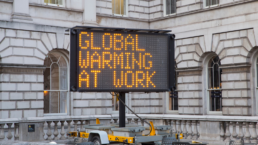A new study finds that 1.5 degrees of warming would cause irreversible changes.
By Bianca Begert, Grist
This story was originally published by Grist. You can subscribe to its weekly newsletter here.
The concept of climate tipping points – when changes in an earth system become self-perpetuating and often irreversible – has been around for decades. In recent years, studies have shown how tree loss within the Amazon, for example, creates a feedback loop where the forest is no longer able to sustain itself, fueling further dieback. Similar dynamics have been observed with permafrost thaw, melting glaciers, and coral reef death.

Now, a new study published in Science warns that the world may have already crossed five of these dangerous thresholds with the 1.1 degrees Celsius (33.98 degrees Fahrenheit) of warming that has already occurred. These include the beginning of the collapse of the Greenland and West Antarctic Ice Sheets, tropical coral reef die off, and the abrupt thawing of Northern permafrost.
The research projects that four of these tipping points will move from possible to likely as global temperatures reach 1.5 degrees C of warming, the goal set by nations in the Paris Agreement in 2015. Several other critical tipping points will become likely if global temperatures surpass the 1.5 degree threshold. These include the loss of Barents Sea ice, the melting of mountain glaciers, the dieback of the Amazon rainforest, and changes to the West African monsoon that will impact the Sahel region of Africa. The dieback of boreal forests and the collapse of the Atlantic meridional overturning circulation, an ocean current which underpins the Gulf Stream, also become possible at 1.5 degrees.
The findings, the first comprehensive assessment of tipping points since 2008, are consistent with a recent report by the Intergovernmental Panel of Climate Change, which showed that some global warming impacts are now unavoidable, even if countries curtail emissions.
“The risk level has gone up since our initial estimates,” said Tim Lenton, a professor of climate change at University of Exeter and one of the new paper’s co-authors. He was also a lead author on the first systematic assessment of climate tipping points in 2008. “Back then, we thought it was 2 degrees of global warming that would push us into the danger zone. But actually, we have already left the space of climate safety.”
The researchers looked at over 200 studies and established minimum and maximum temperature estimates that would trigger various tipping points. “That gave us more basis for not only putting a temperature range on the tipping points, but also hazarding a guess at what temperature would make them likely,” said Lenton. They categorized tipping points as possible when temperatures met the low end of the model estimates, and likely when they passed the center of the range.
“I don’t want people to read this and think, ‘game over,’” said David Armstrong McKay, a climate scientist at the University of Exeter and one of the study’s lead authors. “For the tipping points triggered around 1.5 degrees, there will be huge impacts on people and ecosystems, but those aren’t the ones that have the largest feedback to global warming.” Limiting temperature increases as much as possible would reduce the likelihood of the worst runaway, catastrophic changes.
Some areas needed more research to qualify for inclusion as climate tipping points. For example, the loss of ocean oxygen and changes to the summer monsoon season in India may have a more linear relationship with global temperatures and might not create self-sustaining feedback loops. The researchers also dropped some tipping points that had been included on previous lists, like the loss of Arctic summer sea ice, which may not be self-perpetuating.
Currently, the world is on track to warm about 2.6 to 3 degrees C based on current policies. Even if all current net-zero and emission reduction goals are met, warming would be kept to just below 2 degrees C, which would likely cross six tipping points, according to the study.
“I believe the best – and possibly last – hope we have is to find and trigger good tipping points in society,” said Lenton. “Accelerating the uptake of renewable energy and clean transportation is an example of that.”
Still, the world should prepare for a future where we do pass tipping points, he said. “I don’t want to throw in the towel, but for some things that are likely, such as sea-level rise and coral reef loss, it would be prudent to be planning.”
Recent Posts
The Rage Of Billionaires And The Frenzy To Stop Zohran Mamdani From Becoming New York’s Mayor
June 30, 2025
Take Action Now The constellation of forces now regrouping with a vengeance includes titans of Wall Street, enormous real estate interests,…
It’s Not Just The Cities. Extreme Heat Is A Growing Threat To Rural America.
June 28, 2025
Take Action Now The urban heat island sits in a rural heat ocean.By Umair Irfan, Vox Summer has officially begun with a blast of scorching…
Mamdani’s Massive Victory Should Show Democrats Where The Party’s Future Lies
June 27, 2025
Take Action Now NYC mayoral candidate Zohran Mamdani has thrown the drowning Democratic Party a life vest. Will its leaders use it?By Sam…
India Walton’s Advice For Zohran Mamdani
June 26, 2025
Take Action Now “I think that for him, the race ’til November needs to be staying on message—we can’t start to water it down…




